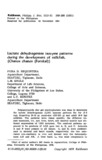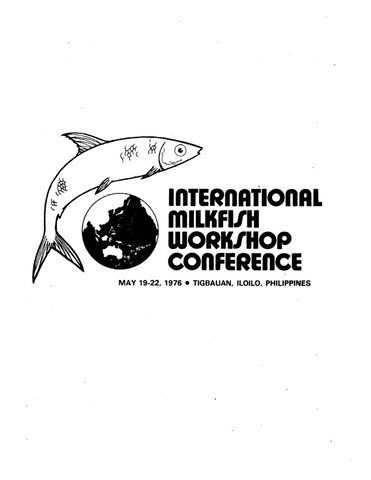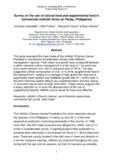Lactate dehydrogenase isozyme patterns during the development of milkfish, (Chanos chanos (Forskal))
- Global styles
- MLA
- Vancouver
- Elsevier - Harvard
- APA
- Help

View/
Date
1981Page views
3,030ASFA keyword
AGROVOC keyword
Taxonomic term
Metadata
Show full item record
Share
Abstract
Polyacrylamide disc gel electrophoresis was done to determine the lactate dehydrogenase (LDH) isozyme patterns for fry (5-3 mg), fingerling (6-12 g), pond-size (150-250 g) and adult (6-9 kg) milkfish. The patterns were tissue specific; the different tissues examined, viz., eye, liver, heart, and skeletal muscle had different expressions of LDH isozymes. The resolved patterns appeared to be products of LDH gene loci A, B, and C. Subunits A and B were present in all tissues. A4 and B4 were predominant in skeletal and heart muscle, respectively; the two associated non-randomly in vivo and formed only the heteropolymers A3B and AB3. A liver band, L4, was most conspicuous in the fingerling, pond-size, and adult; it was assumed to be coded by locus C. A negatively charged band, X4, was detected in fully developed ovary and in fry homogenized as whole individuals, but it could not be resolved in tissues of fingerling.
Six-mo old stunts and 3-mo old fingerlings had similar LDH patterns for all tissues examined. The patterns for 11-mo old stunts and fingerlings also were similar but the one for the eye of the former was the same pattern resolved for the eye of adults.
There was no change in the LDH isozyme patterns of milk fish stunted for 6 mo under different salinity levels (0-5, 15-20, 32-35 ppt).
Suggested Citation
Requintina, P. D., Engle, L. M., & Benitez, L. V. (1981). Lactate dehydrogenase isozyme patterns during the development of milkfish, (Chanos chanos (Forskal)). Kalikasan, The Philippine Journal of Biology , 10(2-3), 289-299. http://hdl.handle.net/10862/1118
Type
ArticleISSN
0115-0553Collections
- Journal Articles [1229]
Related items
Showing items related by title, author, creator and subject.
-
International Milkfish Workshop Conference, May 19-22, 1976, Tigbauan, Iloilo, Philippines
Southeast Asian Fisheries Development Center, Aquaculture Department; International Development Research Centre (Aquaculture Department, Southeast Asian Fisheries Development Center, 1976) -
Survey on the use of natural food and supplemental feed in commercial milkfish farms on Panay, Philippines
Lückstädt, Christian; Focken, Ulfert; Coloso, Relicardo; Becker, Klaus (Stuttgart University, 2000)This study evaluated the feed intake of the milkfish (Chanos chanos Forsskål) in commercial brackishwater ponds under different management regimes. Feed intake and growth were compared between a rather intensive culture ... -
Ongoing research studies on maturation and spawning of milkfish, Chanos chanos at the brackishwater shrimp and milkfish culture applied research and training project, Jepara, Indonesia
Alikunhi, K. H. (Aquaculture Department, Southeast Asian Fisheries Development Center, 1976)The paper gives an account of the research work carried out at Jepara, Indonesia, on induction of maturity of milkfish in ponds and enclosures, and procurement of the spawners from the wild for seed production by hypophysation. ...





